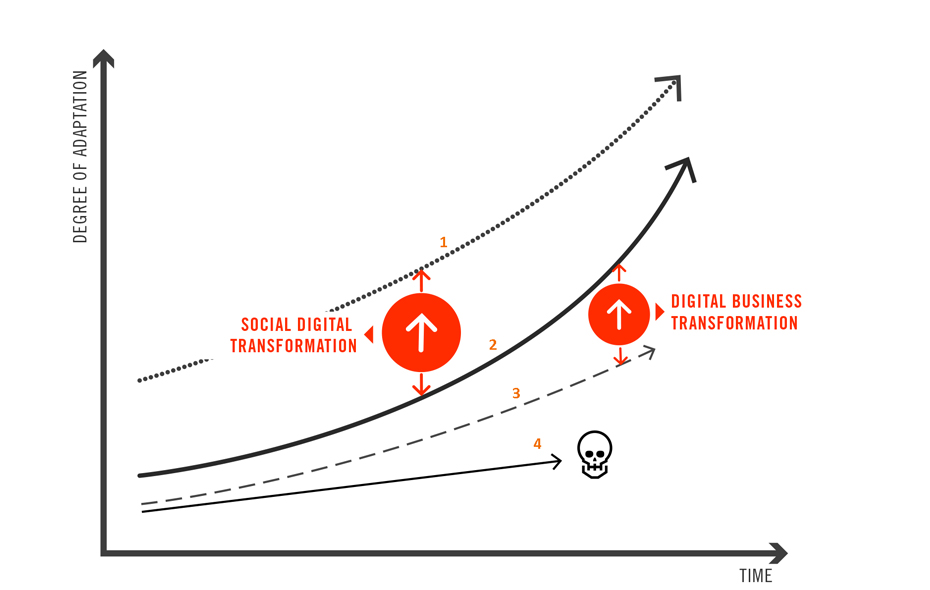Get in touch
Two years ago, I explained digital transformation with a simple diagram. To my surprise it was extremely well received and quickly picked up. The model was adopted by many industry colleagues, used in presentations on occasion and referenced in articles. And it granted me hundreds of contacts and conversations with interesting people. Time for a professional remake.
Two things bothered me about the original article from the very beginning. For starters, the, how shall I put it, rather daft title of the original article (Digital Transformation – it’s about adaption, stupid!) and the inferior “quick & dirty” diagram, which, to make matters worse, also contained a “forgotten” cursor image in the screen shot (which also shamelessly shows the level of laziness – I didn’t even want to crop the image).
The thing with the cursor does make for all kinds of amusing stories on occasion, for it generally isn’t recognized at first. When I discover the diagram somewhere, I sometimes jokingly ask whether that’s a screen shot of my blog. Appropriately, there is great confusion each time, for the people de facto copied it (something I’m completely fine with). Well, enough anecdotes – let’s get back to the business at hand.
Digital transformation is the current buzzword at the C-level and with marketing types. However, I’ve repeatedly observed that though there are many people who use the term, the fewest of them actually know what it means. Well, it’s really quite simple: It’s all about the adaptation of technology by customers/individuals and companies.
If a technology exists, then it will be used sooner or later.
The essential factor of this is when a technology is used by a broad mass of customers and how companies react to the situation. Basically, digital transformation is about the following:

This curve shows the course of technological development. It goes without saying that technological development is always ahead of the adaptation by users and companies.
This curves shows adaptation of the technology by society, resp. (as we are talking about the business context here) the customers. It is typical that when a new technology is introduced, customers use it only haltingly at first. Once a critical mass of users has been reached, adaptation broadens rapidly. The reason for this is simple: We usually are much more likely to do something that our fellow humans also do.
This curve is a simplified depiction of the degree of adaptation by average companies. Traditionally, this curve lags behind social adaptation. If, as is currently the case in the digital revolution, the adaptive behavior of the users changes very quickly, then the companies are caught off guard and fall into obvious arrears. This is what has happened in the last 15 years in the digital sector.
Typically, there are always companies that are unable to adapt to a new market environment. The reasons for this can vary: e.g. missing market analysis, lack of a will to change, missing change management all the way to a stoical “It-has-always-been-this-way-we-have-always-done-it-that-way” attitude. A quick glance back over the lifespan of a human being shows us that there never has been a time where the market environment hasn’t rapidly changed. These companies will not be able to adapt and will drop out of the market sooner or later.
The convergence of the technology adoption curve of the users with the deployed technology can be regarded as social, digital transformation. We can observe this in our own behavior every day. It is the way in which we use new technology - and when. I know, you could cite dozens of examples from your daily lives. If not, please send me an E-Mail. I’m curious whether we really aren’t able to find anything. After all, change isn’t always obvious.
The convergence of the technology adaptation curve of companies with the curve of the users can be described as digital business transformation. Companies must change their communications, products and business models in such a way that their offerings match the needs of the users/customers. That the user and his or her behavior is at the center of this – and not for instance the available technology – is the absolute game changer and crucial to success.
For, if the company aligns itself with currently available technology, it will overwhelm the users/customers and will not reach the critical mass needed to operate its offering economically. There are countless examples for this, e.g. the internationally active premium manufacturer I had the privilege of consulting for several years: At the turn of the millennium, the company invested a large sum of money to create an E-Commerce offering. Unfortunately, the offer never reached desired sales and thus was a debacle internally. If one looks at the adaptation and acceptance of E-Commerce during this time, it quickly becomes clear, that there wasn’t a large need to order things online at the time in question. The company had created an offering that was ahead of the social adaptation of the technology.
In the case of my customer, this experience lead to a traumatic impediment of sorts that still has an impact today; while huge sums are invested in conventional stores, the digital section is fobbed off with a tiny budget. For the second time, the company is running the risk of misjudging the development of user needs.
The model above explains the interaction among technological development, the adaptation of the technology by the customers and the reaction of the companies to the situation. This basically applies to all technologies. What is special about digital technology is the speed with which it has entered into our society. Must companies were, and continue to be, surprised by this and have begun to lag behind – something they must compensate by making a special effort.
You can download a short summary of the digital transformation model here. You can copy, share and adapt all available material. My only request: Please refer back to or link with alainveuve.ch